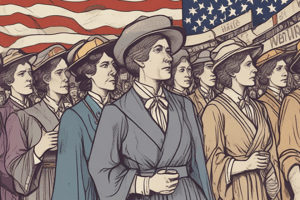Podcast
Questions and Answers
When did women in Manitoba gain the right to vote in provincial elections?
When did women in Manitoba gain the right to vote in provincial elections?
1916
What year did women in Canada gain the right to vote in federal elections?
What year did women in Canada gain the right to vote in federal elections?
1918
In what year were Indigenous peoples in Canada granted the franchise?
In what year were Indigenous peoples in Canada granted the franchise?
1960
When were Inuit in the Arctic able to vote in Canadian elections?
When were Inuit in the Arctic able to vote in Canadian elections?
What section of the Canadian Charter of Rights and Freedoms protects the right of every citizen to vote?
What section of the Canadian Charter of Rights and Freedoms protects the right of every citizen to vote?
Despite a virtually universal franchise in Canada today, what are ongoing challenges related to voting?
Despite a virtually universal franchise in Canada today, what are ongoing challenges related to voting?
When was the Dominion Franchise Act passed and how did it impact Inuit voting rights?
When was the Dominion Franchise Act passed and how did it impact Inuit voting rights?
Which group in Canada experienced no restrictions on their right to vote due to not being covered by treaties or statutes such as the Indian Act?
Which group in Canada experienced no restrictions on their right to vote due to not being covered by treaties or statutes such as the Indian Act?
In which year were status Indians fully enfranchised to vote in Canada?
In which year were status Indians fully enfranchised to vote in Canada?
When did women start voting regularly in Lower Canada and until when did only men have the right to vote?
When did women start voting regularly in Lower Canada and until when did only men have the right to vote?
What characterized the struggle for democratic rights in Canada?
What characterized the struggle for democratic rights in Canada?
Describe the evolution of the right to vote in Canada from its early beginnings to its current state.
Describe the evolution of the right to vote in Canada from its early beginnings to its current state.
Study Notes
The right to vote in Canada has a rich history that reflects the country's evolution as a liberal democracy. The franchise, which denotes the right to vote in elections for members of Parliament, provincial legislatures, and municipal councils, has gone from being held by a small group of Protestant men who owned property to being widely extended to all citizens.
Suffrage Movements in Canada
The struggle for democratic rights in Canada has been marked by centuries of rebellions, riots, protests, and legal challenges. The story of the right to vote in Canada is the story of a chaotic yet persistent pursuit of democratic rights for all citizens.
Enfranchisement of Specific Groups in Canada
The enfranchisement of specific groups in Canada has been a gradual process. For example, women voted regularly in Lower Canada from 1791 until 1849, although for most of this period only men could vote. The franchise was fully extended to status Indians in 1960 under the John Diefenbaker government, 12 years after a parliamentary committee recommended their full enfranchisement. The Dominion Franchise Act (1934) disqualified Inuit from voting in federal elections, but most Inuit were enfranchised in 1950. The Métis have never experienced restrictions on their right to vote, as they have not been covered by treaties or statutes such as the Indian Act, and therefore no legal means have existed to disenfranchise them.
Evolution of Voting Rights in Canada
The development of the franchise in Canada has been characterized by progressive enfranchisement, with the right to vote evolving to include more and more groups. This evolution has been shaped by a combination of legal and social changes, as well as by the efforts of various suffrage movements and activists.
Women's Suffrage in Canada
Women's suffrage in Canada has been a significant part of the history of the right to vote. While women in Lower Canada voted regularly in the early 19th century, the right to vote was not universally extended to women until much later. In 1916, women in Manitoba gained the right to vote in provincial elections, and in 1918, women in the federal election.
Indigenous Voting Rights in Canada
The enfranchisement of Indigenous peoples in Canada has been a complex and evolving process. While the franchise was extended to status Indians in 1960, the history of Indigenous voting rights in Canada is marked by barriers and restrictions. For example, Inuit were rarely enumerated and ballot boxes were not brought to Inuit in the Arctic until the 1962 general election.
Today, Canada has a virtually universal franchise at both the provincial and federal levels, with Section 3 of the Canadian Charter of Rights and Freedoms protecting the right of every citizen to vote in an election of members of the House of Commons or of a legislative assembly. Despite this, there continue to be challenges and barriers to voting that are the subject of ongoing efforts to improve the voting experience for all Canadians.
Studying That Suits You
Use AI to generate personalized quizzes and flashcards to suit your learning preferences.
Description
Test your knowledge about the historical evolution of voting rights in Canada, from the limited franchise of Protestant men to the virtually universal suffrage today. Explore the struggles, movements, and milestones that have shaped the right to vote in Canada.




